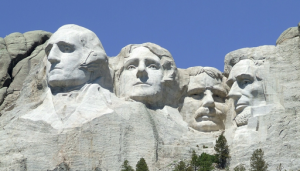Confederate President Jefferson Davis has been toppled from the most iconic street in Richmond, Va., and his neighbor, rebel Gen. Robert E. Lee, may soon follow. A U.S. vice president and ardent slavery defender, John C. Calhoun, was plucked from his 115-foot perch in the center of Charleston, S.C. And President Theodore Roosevelt may soon disappear from the steps of New York City’s American Museum of Natural History.
Is there any monument in the United States that’s too big to fail a racial history test? A piece of public art with a connection to our checkered past that is too important, too monumental, to be removed from the face of America? Could Mt. Rushmore be that ultimate test?
We could soon find out. President Trump is planning to spend Friday watching the fireworks — and, no doubt, lobbing a few verbal ones — in the Black Hills of South Dakota. His visit will likely remind Americans that Rushmore’s presidential problem is as plain as the nose on George Washington’s face. Washington (owner of 123 slaves) and Thomas Jefferson (who enslaved more than 600 humans throughout his life) are only the beginning. Roosevelt’s mixed legacy — the Smithsonian flat-out calls him a “racist” even while noting he invited Booker T. Washington to dine at the White House — adds another pockmark on those faces of history.
PM Mitsotakis announces €3.5 billion support measures for economy
Yet Mt. Rushmore’s hold on history is threatened by elements that go beyond the question of whether its subjects merit memorializing. Even before the first chip of rock had been hewn from the mountainside, Native Americans objected that the carving was on land they considered both sacred and stolen. Less controversial at the time was the past of Rushmore’s creator, an enigmatic Danish American named Gutzon Borglum. By the early 1900s Borglum was a celebrated sculptor, especially of Lincoln statues. He was also an avowed racist.
Read more: The Los Angeles Times
Ask me anything
Explore related questions





